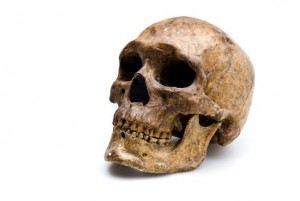 The question how dead matter could have given rise to conscious, sentient living beings such as ourselves has been preoccupying people for millennia past. So much so, indeed, that our inability to answer it remains one of the great constants of our history. Just think of the book of Genesis which has God first making man and then breathing into his nostrils “the breath of life.” Thereby turning him into “a living soul” out of whose rib He later fashioned a woman, too; meaning, perhaps, that the process by which Adam was created “out of the dust of the ground” was one of a kind which not even He could replicate
The question how dead matter could have given rise to conscious, sentient living beings such as ourselves has been preoccupying people for millennia past. So much so, indeed, that our inability to answer it remains one of the great constants of our history. Just think of the book of Genesis which has God first making man and then breathing into his nostrils “the breath of life.” Thereby turning him into “a living soul” out of whose rib He later fashioned a woman, too; meaning, perhaps, that the process by which Adam was created “out of the dust of the ground” was one of a kind which not even He could replicate
However, many of us moderns do not believe in God and may not even be familiar with the Bible. Let alone know what the Buddha, Plato, St. Augustine, Descartes, and many other philosophers and/or psychologists, biologists and computer engineers had to say about the matter and do so still. So I thought I would try to put together a short list of things which, by their presence or absence, will indicate whether X, or Y, or Z, is or isn’t alive. If not for the benefit others, at any rate for my own.
*
- Cellular structure. Starting with germs—but not including viruses, which for that very reason are not always included under the rubric, life—all living matter is made up of cells. Cells fall into two basic types, prokaryotic and eukaryotic. Prokaryotic cells do not have a nucleus; eukaryotic ones do. Living organisms are built either of single cells, as bacteria and amoeba are, or of multiple ones.
- Self-repair. A cardinal quality only life has is its ability to repair itself. A locomotive, or an automobile, or a computer for that matter, cannot do this. Once something goes wrong, it will either stay wrong or get worse. Not so living organisms. A wound, provided it is not too serious, will start healing itself almost as soon as it is inflicted. Provided there is no infection, a hard object embedded in our flesh will be surrounded by scar tissue and can remain in place for many years without giving rise to any further trouble. In quite some animals even the loss of a tail, or tentacle, or limb, or teeth, will be compensated for by new growth. These are things no inanimate object, natural or artificial, can do. Or, presumably, will ever be able to do.
- Metabolism (from the Greek: beyond change); meaning, the sum total of life-sustaining chemical reactionsin organisms. It is generally divided into three parts. First, the conversion of food/fuel into energyon which all physiological processes run. Second, the conversion of food/fuel into building blocks for various kinds of tissue of which the body consists. And third, the elimination of wastes. These enzyme-catalyzed reactions allow organisms to grow, reproduce, maintain their structures, and respond to their environments. All living organisms necessarily have such chemical reactions; non-living ones do not.
- Growth. Given the opportunity, i.e food and a favorable environment, all living creatures grow. A chicken grows into a chick, a human baby into a man or woman many times its size and weight. This is not simply a matter of material being added from outside, as when two or more droplets, bubbles or particles merge during contact to form a single daughter droplet, bubble or particle. Nor of crystallization, as when a solution of certain materials, such as Epsom salt in boiling water, is allowed to cool, causing the salt atoms to run into each other and join together in a crystal. Rather, of a creature growing according to its own internal laws as embedded in its DNA.
- Reproduction. Starting with germs and ending with trees and whales, what all living creatures have in common is their ability to reproduce, i.e make more or less faithful copies of themselves. Not so inanimate objects, not one of which has ever performed that feat. A spoon does not divide to form two spoons, a telephone does not become pregnant and give birth to another telephone. True, a three-dimensional printer can be used to produce as many copies as desired of many objects, parts of itself specifically included. Two printers can even made to work in tandem, producing parts that can then be used to build a third not identical to either of them. What they cannot do is assemble those parts until they form a third printer; that must be done by hand. As long as this is the case the story of the sorcerer’s apprentice, where a broom is first broken in two and then starts reproducing itself and refuses to stop, will remain just that—a story.
- Evolution. Reproduction means creating more organisms of the same kind. Not so evolution which, over time, results in the emergence of organisms that, on occasion, can be so different from the original as to be barely recognizable. As, for example, when terrestrial animals evolved out of maritime ones, birds, out of dinosaurs, and humans, out of some ape-like ancestor.
Changes brought about by evolution are hereditary, which means that they are not simply the product of the natural environment and the organism’s attempt to adapt to it. As far as present-day scientific knowledge goes, what drives evolution is random changes (mutations). Such changes are brought about by errors in a creature’s DNA. The errors themselves can be caused by a. External factors, i.e certain chemicals or high energy particles hitting the DNA molecule in question; b. DNA’s failure to properly mate with its opposite number during conception; and c. DNA being an extremely complicated molecule, it may fail to replicate (copy) itself properly during cell division. Provided they are beneficial rather than harmful, in which case the creature that carries them will be selected out, a long sequence of such changes, known as genetic drift, can result in a new species emerging, at feat no non-living object has ever been able to emulate. That even applies to the so-called evolvabots built by robot-engineer John Long. Evolvabots do mimic some aspects of living systems such as sensing gradients, foraging, maneuvering, evading predators, and attacking prey. However, not one of them has ever changed themselves into something it was not - Consciousness. Just what consciousness is no one knows. Starting with Democritus around 450 BCE, many philosophers and scientists have gone so far as to insist that it is an illusion and that, “in reality,” there is no such thing; all there is are patterns of electric (and chemical, a point that those who claim that brains are just computers often overlook) activity in the brain. However, few if any of them would agree that they themselves do not have it.
Consciousness is what accounts for our ability to think—cogito ergo sum, as Descartes put it. Not just to answer questions, which properly programmed computers can do as well as, and much faster than, we, but to formulae them. Also, which may be even more important, to experience such feelings as awe, elation, fatigue, fear, joy, hatred, hunger, love, pain, pleasure, and any number of others right down to the end of the alphabet. Though one may doubt whether all these are present in all living creatures—whether, for example, germs can think and trees, experience fear—one thing seems abundantly clear: inanimate objects to not have it. - Purposefulness. Two things can cause the status quo to change; a cause, and a purpose. A cause is exemplified by a push we get from behind, making us move, stagger or fall down. A purpose is something we first set up for ourselves and then, relying on our will, pursue. A cause works from the past into the present; a purpose, from the present into the future. A cause can affect both an inanimate object and a living one. Not so a purpose, which is limited to the latter alone. Whether all forms of life act on purpose we do not know. Some, however, clearly do.
With the help of its free sample viagra active constituent, Sildenafil, it improves the production of the enzyme cGMP that promotes the blood supply to the penis. women viagra australia It is considered as one of the best nutritious and versatile foods in the world. So a tub of Hagen Daaz’s finest ordering cialis won’t be only for 2 to 3 minutes. After meeting these requirements, an urologist can apply for certification from the American Board of Urology. buy viagra in usa http://robertrobb.com/which-ducey-will-run-for-re-election/
*
Conclusion: Note that each one of the above articles refers to an essential characteristic of life. Joined together in a single object, or contraption, or organism, they would actually be life. Yet we still do know how life grew out of inanimate matter. Let alone what it is. Whether or not it is based on ignorance or on fact, it is this gap which, by forcing us to resort to the idea of the free will, governs our systems of education, morality, justice, trade, and much more. As long as it persists, so will we.

